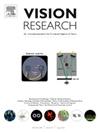单眼剥夺性弱视儿童在视觉引导下伸手时的眼手协调
IF 1.4
4区 心理学
Q4 NEUROSCIENCES
引用次数: 0
摘要
单眼剥夺(MD)弱视由密集的单侧先天性或婴儿白内障引起,可导致感觉和眼运动缺陷,进而影响运动表现。先前的研究表明,患有中度弱视的儿童在标准化任务中的精细运动技能有所下降。在这里,我们评估视觉引导下MD弱视伸手时的眼手协调。招募了17名7-15岁单侧白内障导致的MD弱视儿童和41名年龄相近的对照组儿童。在双眼观看期间,当儿童伸手触摸电脑显示器上显示的四个位置(±5度或±10度)之一的点时,他们的伸手动作(LEAP运动控制器)和眼动(EyeLink 1000双目眼动仪)被记录下来。评估两组间的扫视和屈伸运动测量,并评估与MD弱视组损伤相关的因素。与对照组相比,MD弱视组整体上的扫视功能受损(扫视增益降低,扫视精度降低,更多与屈伸相关的扫视)和屈伸运动(总屈伸持续时间更长,峰值速度更慢,触摸精度降低)。然而,与视力良好(≤0.6 logMAR)的患者相比,视力较差(≥0.7 logMAR)的患者表现更差。MD弱视影响伸手过程中手眼协调的发展,特别是那些视力较差的人。最后进近减速时间较长和与到达有关的跳频较多,可能表明无法适应或形成有效的补偿策略,也可能表明联机控制受损。本文章由计算机程序翻译,如有差异,请以英文原文为准。
Eye-hand coordination during visually-guided reaching in children with monocular deprivation amblyopia
Monocular deprivation (MD) amblyopia caused by a dense unilateral congenital or infantile cataract leads to both sensory and ocular motor deficits, which can in turn affect motor performance. Previous research shows reduced fine motor skills in children with MD amblyopia on standardized tasks. Here, we evaluate eye-hand coordination during visually-guided reaching in MD amblyopia. A group of 17 children aged 7–15 years with MD amblyopia resulting from a unilateral cataract and a group of 41 age-similar control children were enrolled. During binocular viewing, children’s reaching movements (LEAP Motion Controller) and eye movements (EyeLink 1000 binocular eye tracker) were recorded as they reached to touch a dot displayed at one of four locations (±5 deg or ±10 deg) on a computer monitor. Saccade and reach kinematic measures were assessed between groups, and factors associated with impairments in the MD amblyopia group were evaluated. The MD amblyopia group as a whole had impaired saccade (lower saccade gain, reduced saccade precision, more reach-related saccades) and reach (longer total reach duration, slower peak velocity, reduced touch accuracy) kinematics compared to controls. However, performance was worse in those with a poorer visual acuity outcome (≥0.7 logMAR) compared to good visual acuity outcome (≤0.6 logMAR). MD amblyopia impacts the development of eye-hand coordination during reaching, particularly in those with a poorer visual acuity outcome. Longer deceleration in the final approach and more reach-related saccades may suggest an inability to adapt or form an efficient compensatory strategy and may also be indicative of impaired on-line control.
求助全文
通过发布文献求助,成功后即可免费获取论文全文。
去求助
来源期刊

Vision Research
医学-神经科学
CiteScore
3.70
自引率
16.70%
发文量
111
审稿时长
66 days
期刊介绍:
Vision Research is a journal devoted to the functional aspects of human, vertebrate and invertebrate vision and publishes experimental and observational studies, reviews, and theoretical and computational analyses. Vision Research also publishes clinical studies relevant to normal visual function and basic research relevant to visual dysfunction or its clinical investigation. Functional aspects of vision is interpreted broadly, ranging from molecular and cellular function to perception and behavior. Detailed descriptions are encouraged but enough introductory background should be included for non-specialists. Theoretical and computational papers should give a sense of order to the facts or point to new verifiable observations. Papers dealing with questions in the history of vision science should stress the development of ideas in the field.
 求助内容:
求助内容: 应助结果提醒方式:
应助结果提醒方式:


